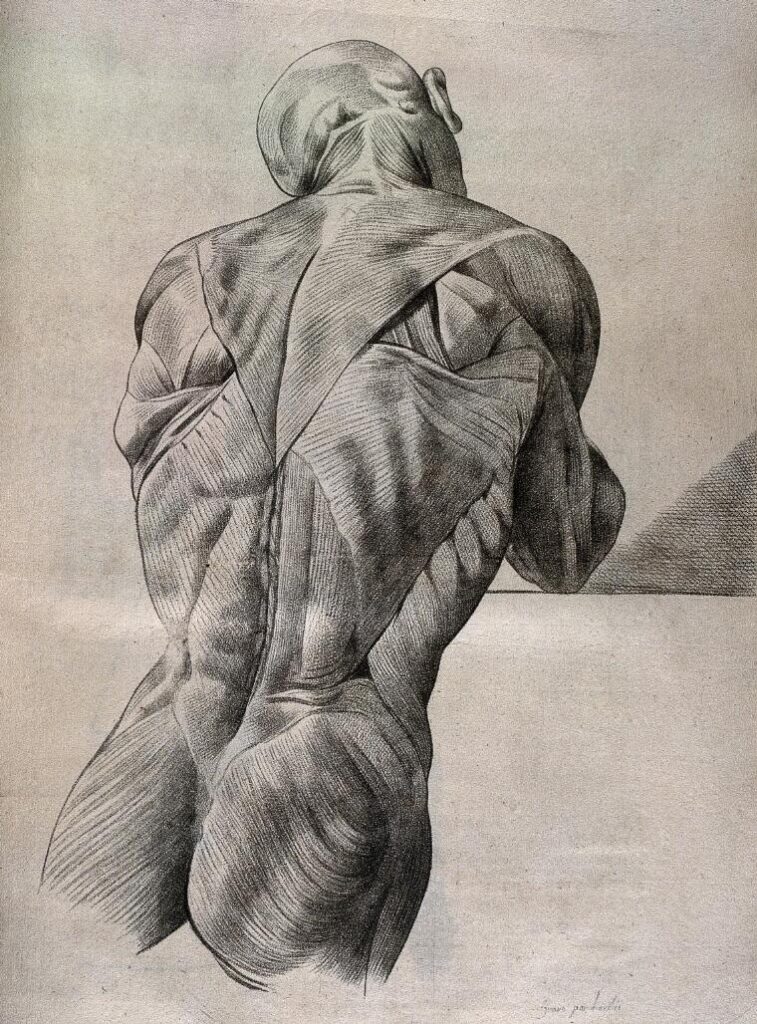Alfred David
Port Harcourt, Rivers, Nigeria

Muscles of an écorché figure, shown from head to buttock, seen from behind. Crayon manner print by Lavalée after J. Gamelin, 1778/1779. Wellcome Collection. Public domain.
What sacrifices must be made in order to practice medicine? Choosing to study medicine is never a choice that should made lightly. The scope of knowledge in its various disciplines is vast, requiring an immense amount of dedication and attention to detail. Finances, social life, and a portion of one’s mental health are but a few casualties during the process of becoming a medical doctor.
Certain motivations are needed in order to survive medical school. They can be grouped into three phases: in the beginning, one enters armed with the reasons that drove them to choose medicine. At the end lies the reward of being a medical doctor. However, there still exists a middle zone, which ideally should be guided by an enjoyment of the study of medicine. A certain comfort must be derived from the process, a comfort that enables one to smile amidst the challenges. My middle zone contains my choice to see the process as a creative form of art—I find comfort in the art embedded in medicine and in my appreciation of the human body.
The human body is the embodiment of perfect artistic expression. One way to experience its beauty is by viewing it as an orchestra, with each part playing a different instrument, that together creates the beautiful symphony we call life. Just as an orchestra requires coordination and collaboration between the different instruments, so the body too relies on complex interactions between its organs, tissues, and cells to function properly. Both orchestra and body can easily become discordant when one part or section is out of tune or misses a cue. When all parts are playing seamlessly together, however, we can appreciate the complexity, interconnectedness, beauty, and harmony that results.
If you are looking for art in medicine, there is no better place to start than with anatomy. Looking through an anatomy atlas, one cannot help but be impressed by the intricate nature of the human body. Anatomy is where art and medicine intersect—and the influence of artists on this field of medicine cannot go unnoticed. The foundation of modern anatomical illustrations was laid by Renaissance artists such as Leonardo da Vinci and Michelangelo, who not only watched medically trained persons perform dissections but also picked up the scalpel themselves and used their skills to create highly detailed and accurate anatomical drawings. Through the years, many professionals and anatomical illustrators have collaborated to create illustrations and animations that help one understand the human body and diagnose diseases.
When I study medicine, I view myself as a painter working on a very large canvas. A painter working on a large canvas starts at different points on the canvas and to an onlooker, the work may look dysfunctional. As he or she continues to paint, some areas begin to look more distinct, colors more vibrant, and the general concept of the artwork begins to show. With each stroke of the brush encroaching on spaces that were once empty, the painting begins to take life and all those little components which were once scattered about on the canvas form a beautiful coherent composition. Muscles, blood vessels, and enzymes now acquire specificity, each muscle having its peculiar name with origins and insertions on definite parts of the skeletal bones, blood vessels coursing through the body with their names changing as they pass certain landmarks. As time went by, the information I gathered began to interconnect, and a wider view of medical concepts became visible. In those quiet little moments, when the things I had read began to make sense as a whole, I was elated, and this gave me a drive to continue to add more knowledge in order to see what the whole painting would look like.
Perhaps I have romanticized, to some extent, a process of learning that I initially portrayed as grim. The motivations that occupy the “middle zone” of medical school are meant to let one see the process through rose-colored glasses, making the study of medicine a relatively fun experience, the strenuous journey a little less tasking. If you decide to study medicine or are actively studying it, please make sure to find your own outlet that allows you to enjoy the process and lightens its burdens a little bit.
ALFRED DAVID is a third-year medical student at the University of Ife and an artist who spends his free time painting and writing.
Submitted for the 2022–23 Medical Student Essay Contest and Highlighted Vignette Volume 15, Issue 3 – Summer 2023

Leave a Reply